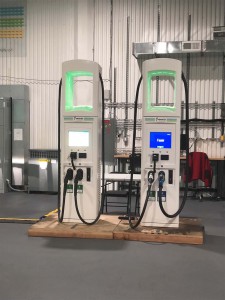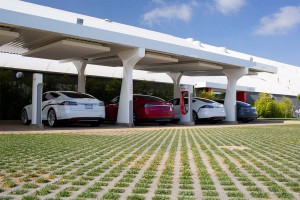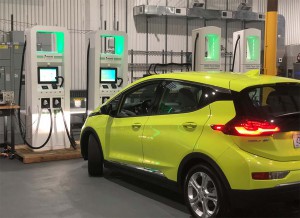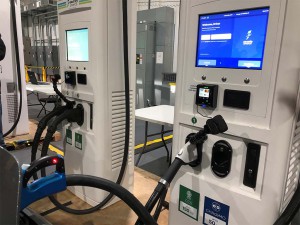Volkswagen plans to spend $50 billion on battery-electric vehicles while General Motors’ CEO says the automaker is on a “path” to go fully electric. Volvo, Nissan, Toyota, Ford and, of course, Tesla, by mid-decade, these and other manufacturers expect to have more than 200 electric vehicles on the market.
But just because you build them doesn’t mean buyers will come, industry analysts warn, pointing to a variety of obstacles to mass acceptance of battery-electric vehicles, or BEVs, including range and cost. But one of the biggest concerns is the lack of a viable charging infrastructure that would allow electric vehicle owners to travel as freely as do owners of conventional gas and diesel-powered vehicles.
That is beginning to change as charging stations, especially “Level 3” fast chargers begin to pop up across the countryside. And, ironically, that roll-out owes a fair share of credit to Volkswagen’s diesel emissions scandal. Out of the roughly $30 billion the automaker has so far paid out in terms of fines and settlements, $2 billion is funding Electrify America, a start-up helping promote the adoption of plug-based vehicles, in large part by setting up the fastest-growing public charging network in the U.S.
EA is taking another step to increase the appeal of running on battery-power, on Monday announcing plans to cut the cost of charging at one of its stations by 20 percent.
(Google wants to take the guesswork out of EV charging. Click Here to find out how.)
“Longer range and faster charging times are critical to the widespread adoption of electric vehicles,” said Brendan Jones, the chief operation officer at Electrify America, during a conversation at the company’s headquarters in the Washington, D.C. suburb of Reston, Virginia.
Though housed in the same building as Volkswagen’s own U.S. headquarters, Electrify America, or EA, is required to function as an independent entity. It has been working with a wide array of competing manufacturers, such as BMW and General Motors, both of whose battery cars appeared in ads EA ran online and on network broadcasts last year promoting electric vehicles.
That said, it’s Volkswagen that is funding the start-up to the tune of $2 billion which will spent over a 10-year period through the end of 2026. After that, EA is betting it will have turned its charging network into a viable commercial venture that can stand on its own.
The money will be spent in four 2.5-year “cycles,” according to the company’s President and CEO Giovanni Palazzo, the bulk of it being used to set up a charging network that will eventually crisscross the country. The first of its charging stations went into operation exactly a year ago this week and EA had added 158 more by the first anniversary, with dozens of additional facilities in development. Each charging station has an average four to five individual charger in place, with a maximum 10 at any location.
Initially, the company is focusing on areas where battery-cars are already gaining traction, notably California and parts of the East Coast. Over the next couple cycles it plans to enter a variety of other regions, eventually covering all but a handful of states like the Dakotas. The key, said Jones, is to emphasize places like the Ohio Turnpike – where two stations recently opened – to serve cross-country travelers.

Four different suppliers provide chargers to Electrify America but all are designed to work the same way.
In many places, EA is teaming up with major mall operators and retail giants like Wal-Mart to place charging stations where there’s lots of traffic. It has also partnered with Sheetz, which operates a network of gas stations. Eventually, said Jones, he expects energy companies will want to serve customers by providing whatever form of “fuel” they need.
In terms of raw numbers, EA still lags competitors like EVgo and ChargePoint — as well as the dedicated Supercharger network Tesla is setting up. But the pace at which the VW-funded venture is opening new facilities “beats everyone, even Tesla,” said Jones, noting the goal is to have 2,000 chargers operational by late June, the end of EA’s first cycle.
Before the VW-funded fourth cycle is completed, the goal is to leave no more than 70 miles between EA charging stations, even in the most remote regions of the U.S.
That will include a mix of different types of chargers. In some locations, it’s providing Level 2 systems that provide 240-volt power, much like the typical home system. These typically require a vehicle to be hooked up overnight to get a full charge, especially long-range BEVs like the Chevrolet Bolt EV and the Hyundai Kona.
But EA is emphasizing Level 3 fast-chargers. As recently as mid-decade there were only a handful of these in the entire U.S. but today they are popping up with ever greater frequency. Initial, Level 3 systems provided 50 kilowatts of power at 400 volts, enough to give a vehicle like the Chevy Bolt an 80% “fill up” in about an hour. But EA is rapidly upgrading its network to 150 kW systems and, where possible, chargers that can up the power level to 350 kW at 800 volts.
The first vehicle to make use of that technology, the Porsche Taycan, will be able to recharge at the rate of an additional 20 miles per minute. Since most customers are coming in when their batteries are down to about a quarter to a third of their peak capacity, said Palazzo, they’ll be able to top off in around 10 minutes, or roughly the time it takes an owner of a gas-powered vehicle to fill up.
(Those winter chills take a hard toll on EV battery range. Click Here for the story.)

EA is one of a number of companies setting up public chargers across the U.S., as is Tesla, one of its Supercharger stations shown here.
To make things easier – and more affordable, EA announced today it is cutting its charging costs by 20 percent. It also is taking a series of steps to speed up the charging process, this week is rolling out a new smartphone app that can be used to not only locate one of its charging stations but even to see how long it will be for someone already hooked up to finish charging.
At EA’s technical center, a short drive from its Reston HQ, Seth Cutler, the company’s chief engineer, demonstrates what he hopes will make things even easier for customers. Normally, a user has to plug their vehicle in and go through a set-up process similar to paying for a tank of gas. But this time, as Cutler plugs a battery-car into a charger prototype, everything is handled automatically. New software allows the charger to query the vehicle’s own system to find out how much power it can handle and how to bill it. That saves another minute or two.
Eventually EA hopes to have thousands of charging stations operating across the country, with its competitors promising to have thousands of their own. That said, there will likely be far fewer of them than there are service stations today. The need simply won’t be there, said Jones, noting that BEV owners currently do 80% of their charging at home, even if there’s a quicker Level 3 system nearby.
That could change a bit in the future as battery-electric vehicles become more ubiquitous. A number of fleet operators are planning to switch, citing lower energy costs, for one thing. But charging at home, office or central fleet depots will likely to continue to account for the bulk of charging, EA officials said, and competitors such as ChargePoint are laying out plans based on similar expectations.
Nonetheless, industry analysts believe that even with the charging networks EA and competitors are laying out it will become far easier and more appealing for motorists to seamlessly make the switch from gas to electric propulsion.
(Tesla raises $100s of mil more new capital than planned. Click Here for the story.)
(Electrify America provided transportation and lodging related to covering this story.)


